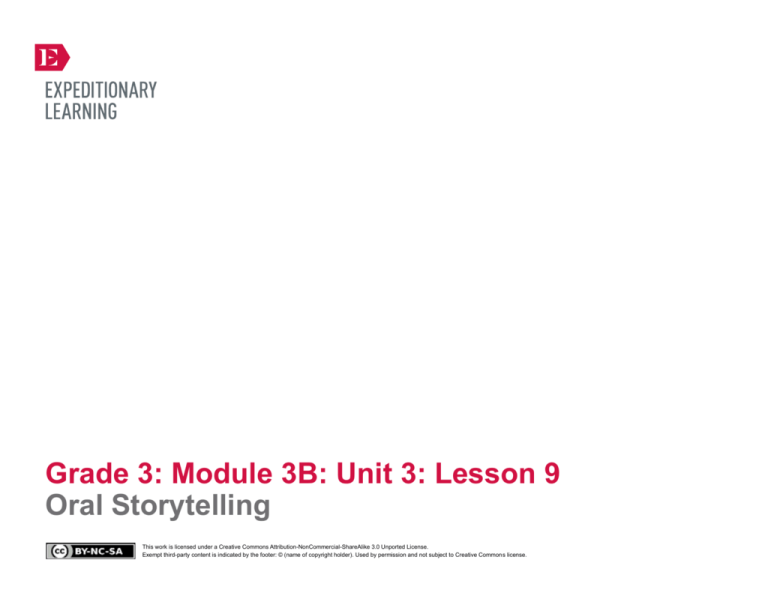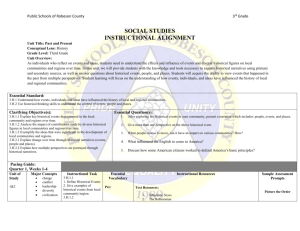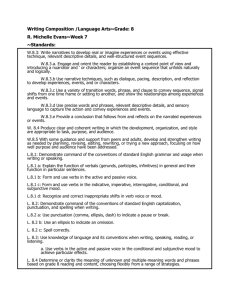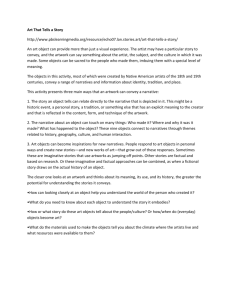
Grade 3: Module 3B: Unit 3: Lesson 9
Oral Storytelling
This work is licensed under a Creative Commons Attribution-NonCommercial-ShareAlike 3.0 Unported License.
Exempt third-party content is indicated by the footer: © (name of copyright holder). Used by permission and not subject to Creative Commons license.
GRADE 3: MODULE 3B: UNIT 3: LESSON 9
Oral Storytelling
Long-Term Targets Addressed (Based on NYSP12 ELA CCLS)
I can craft narrative texts about real or imagined experiences or events. (W.3.3)
a. I can establish a situation.
a. I can introduce the narrator and/or characters of my narrative.
a. I can organize events in an order that makes sense in my narrative.
a. I can use dialogue to show the actions, thoughts and feelings of my characters.
b. I can use descriptive words to show the actions, thoughts and feelings of my characters.
c. I can use transitional words and expressions to show passage of time in a narrative text.
d. I can write a conclusion to my narrative.
Supporting Learning Target
Ongoing Assessment
• I can share my story orally.
Created by Expeditionary Learning, on behalf of Public Consulting Group, Inc.
© Public Consulting Group, Inc., with a perpetual license granted to Expeditionary Learning Outward Bound, Inc.
NYS Common Core ELA Curriculum • G3:M3B:U3:L9 • June 2014 • 1
GRADE 3: MODULE 3B: UNIT 3: LESSON 9
Oral Storytelling
Agenda
Teaching Notes
1. Opening
• In preparation for writing their Wolf Narratives for the End of Unit 3 Assessment in the next lesson,
students orally share their narratives in this lesson. The teacher demonstrates the process using the
Wolf Narrative plan for “Little Foot and the Trap.” Some example modeling has also been included in
Work Time A.
A. Unpacking Learning Targets (5 minutes)
2. Work Time
A. Modeling Oral Retelling and Practice (30 minutes)
B. Sharing Narratives (20 minutes)
3. Closing and Assessment
A. Debrief the Oral Storytelling Process (5 minutes)
4. Homework
A. Follow the directions on the Wolf Narrative
storyboard to draw your narrative in pictures.
B. Continue reading your independent reading book.
• At the end of the lesson, students tell their narratives to a partner and provide a suggestion for
improvement. To scaffold this, students are given a set of questions to consider as they listen to their
partners’ narratives. To set this activity up in a way that encourages students to be kind and considerate
to each other when providing suggestions, this process is also modeled first.
• For homework, students draw out their narratives on storyboard to reinforce their ideas before they
write their Wolf Narratives in the next lesson. This is an additional opportunity for students to become
clear on the sequence of events in their narratives.
• In advance:
– Make copies of students’ completed Mid-Unit 3 Assessments from Lesson 8. This will allow them to
orally tell their narratives, while still providing you time to continue assessing their work.
– Decide how you will model oral retelling in Work Time A.
– Post: Learning target.
Lesson Vocabulary
Materials
orally
• Mid-Unit 3 Assessments (from Lesson 8; students’ own)
• Wolf Narrative plan for “Little Foot and the Trap” (one to display)
• Giving Feedback: Questions to Consider (one per student and one to display)
• Wolf Narrative storyboard (one per student and one to display)
Created by Expeditionary Learning, on behalf of Public Consulting Group, Inc.
© Public Consulting Group, Inc., with a perpetual license granted to Expeditionary Learning Outward Bound, Inc.
NYS Common Core ELA Curriculum • G3:M3B:U3:L9 • June 2014 • 2
GRADE 3: MODULE 3B: UNIT 3: LESSON 9
Oral Storytelling
Opening
Meeting Students’ Needs
A. Unpacking Learning Targets (5 minutes)
• Direct students’ attention to the posted learning target and read it aloud:
• Posting learning targets allows
students to reference them
throughout the lesson to check their
understanding. The learning targets
also provide a reminder to students
and teachers about the intended
learning behind a given lesson or
activity.
* “I can share my story orally.”
• Ask students to discuss with an elbow partner:
* “What does orally mean?”
• Select volunteers to share their responses. Listen for students to explain that it means to say something aloud.
• Tell students that to prepare for drafting their Wolf Narratives in the next lesson, they are going to practice saying it aloud.
Work Time
Meeting Students’ Needs
A. Modeling Oral Retelling and Practice (30 minutes)
• Return the copies of Mid-Unit 3 Assessments.
• Modeling the process of using the
planning organizer and describing
the thinking behind the process of
orally telling the story will ensure
students understand how to do it
independently.
• Ask students to spend 2 or 3 minutes rereading their plans silently to themselves.
• Display the Wolf Narrative plan for “Little Foot and the Trap.” Explain that you are going to use it to demonstrate
how the planner can be used to prepare for writing.
• Model how to turn the notes on a narrative planner into an oral story using the Wolf Narrative plan for “Little Foot and the
Trap.” Begin by pointing at the Setting column and say something like: “In the North Woods of Minnesota there lives a wolf
pack.”
• Continue by pointing at the Main Character column and saying something like: “Little Foot, a wolf who was named for his
particularly small feet, woke up and stretched. He woke up the rest of the pack. They all stretched and bowed to each other.”
• Remind students that their wolf narratives need to contain details about real wolves to make it seem more realistic, and
explain that in Face to Face with Wolves it says the wolves in the pack bow to each other when they wake up.
• Giving students time to practice
telling their narratives
independently will help to build
their confidence and ensure they
have their own ideas before hearing
those of others.
• Continue modeling by pointing at the first event in the Problem column and saying something like: “The pack went off to
hunt, leaving the pups behind with Bright Eyes, a beautiful wolf with bright green eyes, to look after them. They hadn’t eaten
in a few days so it was important that they catch something today.”
• Again, remind students that their Wolf Narratives need to contain details about real wolves, and in the book Face to Face
Created by Expeditionary Learning, on behalf of Public Consulting Group, Inc.
© Public Consulting Group, Inc., with a perpetual license granted to Expeditionary Learning Outward Bound, Inc.
NYS Common Core ELA Curriculum • G3:M3B:U3:L9 • June 2014 • 3
GRADE 3: MODULE 3B: UNIT 3: LESSON 9
Oral Storytelling
with Wolves it says that one wolf always stays behind with the pups.
Meeting Students’ Needs
Work Time (continued)
• Continue modeling by pointing at the second event in the Problem column and saying something like: “The pack saw some
deer in a clearing in the trees. As the alpha male, Lightning made a lot of the decisions for the pack, so he stopped them to
make a plan. He and Black Ears would chase the deer toward the twins and Little Foot, who would pounce on the deer when
they came close and bring them down.”
• Continue by pointing at the third event in the Problem column and saying something like: “Lightning and Black Ears chased
the deer toward the twins and Little Foot. As Little Foot went to pounce, he got his foot caught in a trap set by hunters to
catch small animals like rabbits and squirrels. The rest of the wolves continued to chase the deer, leaving Little Foot behind.”
• Continue by pointing at the Solution column and saying something like: “The trap was rusty so after trying for a little while,
Little Foot was able to pull himself free, but he was weak and exhausted. The rest of the pack, who had been looking for Little
Foot for hours, eventually found him and helped him back to the rendezvous site.”
• Again, remind students that their Wolf Narratives need to contain details about real wolves, and in the book Face to Face
with Wolves it says that the place where the wolves convene is called the rendezvous site.
• Explain that you are going to give students time to work independently, using the story plan from their Mid-Unit 3
Assessments to practice orally telling their narratives. Tell students they are going to get into pairs to share their narratives
toward the end of the lesson.
• Give students time to practice.
• Consider spreading students out so they don’t interfere with each other’s practice.
• Circulate to support students. Ask guiding questions:
* “How are you introducing the main character?”
* “How are you introducing other characters in the pack?”
* “Are there any details about real wolves you could use to make that section more realistic?”
Created by Expeditionary Learning, on behalf of Public Consulting Group, Inc.
© Public Consulting Group, Inc., with a perpetual license granted to Expeditionary Learning Outward Bound, Inc.
NYS Common Core ELA Curriculum • G3:M3B:U3:L9 • June 2014 • 4
GRADE 3: MODULE 3B: UNIT 3: LESSON 9
Oral Storytelling
Work Time (continued)
Meeting Students’ Needs
B. Sharing Narratives (20 minutes)
• Refocus whole group. Tell students that now that they have had time to practice, they are going to share their narratives with
a partner to get feedback to help them improve their narratives.
• Consider heterogeneous pairings of
students to ensure that at least one
of the students is able to read the
directions.
• Display and distribute the Giving Feedback: Questions to Consider.
• Invite students to follow along silently as you read the directions and the questions aloud.
• Invite students to ask any clarifying questions.
• Ask a volunteer to help you model this process for the whole group. The volunteer will be Author 1 and you will be Author 2,
so you can model the process of providing a suggestion that will help the volunteer to improve his or her story. Explain the
process as you do this; for example, once the student has told you his or her story, you might say to the class:
* “So, reading these questions and hearing my partner’s story, I didn’t hear any details about real wolves, so my suggestion
to my partner is to use more details about real wolves.”
• Emphasize to students that they are not to tell their partners what they don’t like about the story. They are to give just one
suggestion for improvement. Remind students to do this carefully so that they don’t upset or offend their partners.
• Pair students up.
• Invite students to follow the directions to begin telling their stories to each other.
• Circulate to support students as they try to give suggestions for improvement. Ask the questions on the Giving Feedback:
Questions to Consider handout to guide students.
Created by Expeditionary Learning, on behalf of Public Consulting Group, Inc.
© Public Consulting Group, Inc., with a perpetual license granted to Expeditionary Learning Outward Bound, Inc.
NYS Common Core ELA Curriculum • G3:M3B:U3:L9 • June 2014 • 5
GRADE 3: MODULE 3B: UNIT 3: LESSON 9
Oral Storytelling
Closing and Assessment
Meeting Students’ Needs
A. Debrief the Oral Storytelling Process (5 minutes)
• Refocus whole group.
• Debrief the process so that students
recognize how it has prepared them
to write their own narratives.
• Ask students to discuss with their partners:
* “In the next lesson, you are going to be writing your Wolf Narratives. How did telling your story to a partner help you
prepare to write it down?”
• Cold call students to share their responses. Listen for students to explain that they were able to get feedback and suggestions
to improve their work without having to go back and rewrite the narrative.
• Distribute the Wolf Narrative storyboard.
• Read through the directions with students.
Homework
Meeting Students’ Needs
• Follow the directions on the Wolf Narrative storyboard to draw your narrative in pictures.
• Continue reading your independent reading book.
Created by Expeditionary Learning, on behalf of Public Consulting Group, Inc.
© Public Consulting Group, Inc., with a perpetual license granted to Expeditionary Learning Outward Bound, Inc.
NYS Common Core ELA Curriculum • G3:M3B:U3:L9 • June 2014 • 6
Grade 3: Module 3B: Unit 2: Lesson 9
Supporting Materials
This work is licensed under a Creative Commons Attribution-NonCommercial-ShareAlike 3.0 Unported License.
Exempt third-party content is indicated by the footer: © (name of copyright holder). Used by permission and not subject to Creative Commons license.
GRADE 3: MODULE 3B: UNIT 3: LESSON 9
Wolf Narrative Plan for “Little Foot and the Trap”
What is the setting of the narrative?
The North Woods of Minnesota
Who is the main character in the narrative?
Little Foot—a young wolf with particularly small feet that can run fast
What is the problem?
Little Foot gets his foot caught in a trap.
Events:
1. The pack goes out to hunt.
2. They see some deer.
3. As Little Foot goes to pounce on the deer, he gets his foot caught in a trap.
What is the solution?
The trap is rusty and Little Foot manages to pull himself free. The pack finds him and helps him
back to the rendezvous site.
Copyright © 2013 by Expeditionary Learning, New York, NY. All Rights Reserved
NYS Common Core ELA Curriculum • G3:M3B:U3:L9 • June 2014 • 8
GRADE 3: MODULE 3B: UNIT 3: LESSON 9
Giving Feedback: Questions to Consider
Directions:
1. Number yourselves Author 1 and Author 2.
2. Author 1 reads his or her narrative to Author 2.
3. Author 2 listens very carefully.
4. Author 2 reads the questions below.
5. Author 2 uses the questions to make just ONE suggestion to help Author 1 make his or her
narrative better. For example, “You could add more details about real wolves.”
6. Author 2 tells Author 1 the step he or she will take to improve the narrative.
7. Switch roles and repeat.
Questions:
• Did the author introduce the main character and setting at the beginning of the story?
• Did the author include details about real wolves?
• Did the events lead up to the problem?
• Was there anything confusing in the sequence of events?
• Did the solution solve the problem?
• Was there a satisfying ending to the story?
Copyright © 2013 by Expeditionary Learning, New York, NY. All Rights Reserved
NYS Common Core ELA Curriculum • G3:M3B:U3:L9 • June 2014 • 9
GRADE 3: MODULE 3B: UNIT 3: LESSON 9
Wolf Narrative Storyboard
Name:
Date:
Directions: You are going to tell your story in pictures. Draw pictures to tell your story in the large
boxes. In the smaller boxes underneath, write one sentence to describe what is happening in the
picture. You do not have to use all the boxes if you don’t need them. The setting, main character,
problem, events leading up to the problem, and the solution should be clear on your storyboard.
1.
2.
3.
4.
5.
6.
7.
8.
Copyright © 2013 by Expeditionary Learning, New York, NY. All Rights Reserved
NYS Common Core ELA Curriculum • G3:M3B:U3:L9 • June 2014 • 10








